
Metro-North Railroad, trading as MTA Metro-North Railroad, is a suburban commuter rail service operated by the Metropolitan Transportation Authority (MTA), a public authority of the U.S. state of New York. Metro-North serves the New York Metropolitan Area, running service between New York City and its northern suburbs in New York and Connecticut, including Port Jervis, Spring Valley, Poughkeepsie, Yonkers, New Rochelle, Mount Vernon, White Plains, Southeast and Wassaic in New York and Stamford, New Canaan, Danbury, Bridgeport, Waterbury, and New Haven in Connecticut. Service in Connecticut is operated under contract with the Connecticut Department of Transportation. Metro-North also provides local rail service within the New York City boroughs of Manhattan and the Bronx.

Poughkeepsie station is a Metro-North Railroad and Amtrak stop serving the city of Poughkeepsie, New York. The station is the northern terminus of Metro-North's Hudson Line, and an intermediate stop for Amtrak's several Empire Corridor trains.
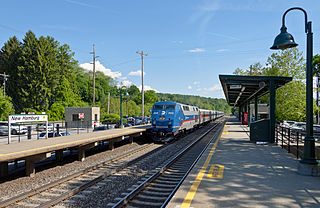
New Hamburg station is a commuter rail stop on the Metro-North Railroad's Hudson Line, serving Wappingers Falls, New York.
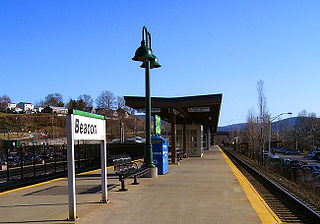
Beacon station is a commuter rail station on the Metro-North Railroad Hudson Line located in Beacon, New York. The station has three tracks, with one island platform and one side platform.
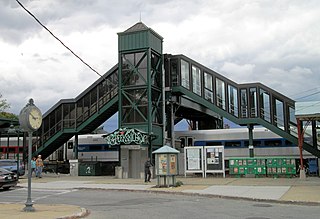
Peekskill station is a commuter rail stop on the Metro-North Railroad's Hudson Line, located in Peekskill, New York.

Croton–Harmon station is a train station in Croton-on-Hudson, New York. It serves the Metro-North Railroad's Hudson Line and all Amtrak lines running along the Empire Corridor. It is the main transfer point between the Hudson Line's local and express service and marks the northern endpoint of third-rail electrification on the route.
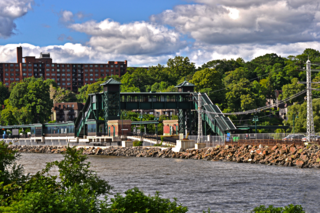
Scarborough station is a commuter rail stop on the Metro-North Railroad's Hudson Line, located in the Scarborough area of Briarcliff Manor, New York. Trains leave for New York City every hour on weekdays, and about every 25 minutes during rush hour. It is 28.7 miles (46.2 km) from Grand Central Terminal, and the trip there takes about 50 minutes. Trains of electric multiple units serve the station. The Scarborough station is within walking distance of most houses in the neighborhood.
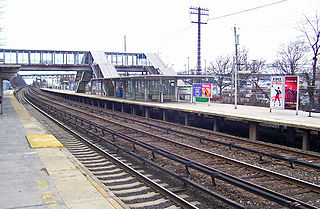
Tarrytown station is a commuter rail stop on the Metro-North Railroad's Hudson Line, located in Tarrytown, New York. The Tappan Zee Bridge is not far from the station, resulting in its use by Rockland County commuters.

Ardsley-on-Hudson station is a commuter rail stop on the Metro-North Railroad's Hudson Line, located in the Ardsley Park area of Irvington, New York. It serves both the neighborhood and the northern part of the village of Dobbs Ferry; the main campus of Mercy College is within walking distance of the station.

Dobbs Ferry station is a commuter rail stop on the Metro-North Railroad's Hudson Line, located in Dobbs Ferry, New York.

Marble Hill station is a commuter rail stop on the Metro-North Railroad's Hudson Line, serving the Marble Hill neighborhood of Manhattan in New York City. The station is located at 125 West 225th Street, two blocks west of the Broadway Bridge on the north side of the Harlem River, near the New York City Subway's Marble Hill–225th Street station.

White Plains station is a commuter rail stop on the Metro-North Railroad's Harlem Line, located in White Plains, New York. With 9,166 daily commuters as of 2006, White Plains is the busiest Metro-North station in Westchester County, the busiest non-terminal or transfer station on the Metro-North system, and the first/last stop outside New York City on most upper Harlem Line express trains.
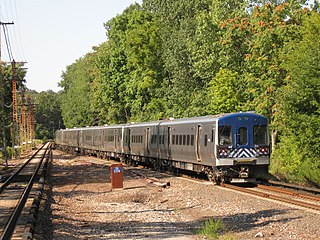
The Harlem Line is an 82-mile (132 km) commuter rail line owned and operated by the Metro-North Railroad in the U.S. state of New York. It runs north from New York City to Wassaic, in eastern Dutchess County. The lower 53 miles (85 km) from Grand Central Terminal to Southeast, in Putnam County, is electrified with a third rail and has at least two tracks. The section north of Southeast is a non-electrified single-track line served by diesel locomotives. Before the renaming of the line in 1983, it eventually became the Harlem Division of the New York Central Railroad. The diesel trains usually run as a shuttle on the northern end of the line, except for rush-hour express trains in the peak direction.

Mount Vernon West station is a commuter rail stop on the Metro-North Railroad's Harlem Line, located in Mount Vernon, New York. Train 352 from Grand Central Terminal terminates here in the PM Rush.

Getty Square is the name for downtown Yonkers, New York, centered on the public square. Getty Square is the civic center, central business district, and transit hub of the City of Yonkers. A dense and growing residential area, it is located in southern Westchester County, New York. The square is named after prominent 19th-century merchant Robert Getty.

The Hudson Line is a commuter rail line owned and operated by the Metro-North Railroad in the U.S. state of New York. It runs north from New York City along the east shore of the Hudson River, terminating at Poughkeepsie. The line was originally the Hudson River Railroad, and eventually became the Hudson Division of the New York Central Railroad. It runs along what was the far southern leg of the Central's famed "Water Level Route" to Chicago.
Philipse Manor may refer to:

Hawthorne station is a commuter rail stop on the Metro-North Railroad's Harlem Line, located in Mount Pleasant, New York.

Port Chester station is a commuter rail station on the Metro-North Railroad New Haven Line, located in Port Chester, New York. The station is the northernmost station on the line in New York before crossing into Connecticut. The station has two high-level side platforms, each 10 cars long, serving the outer tracks of the four-track Northeast Corridor.





















